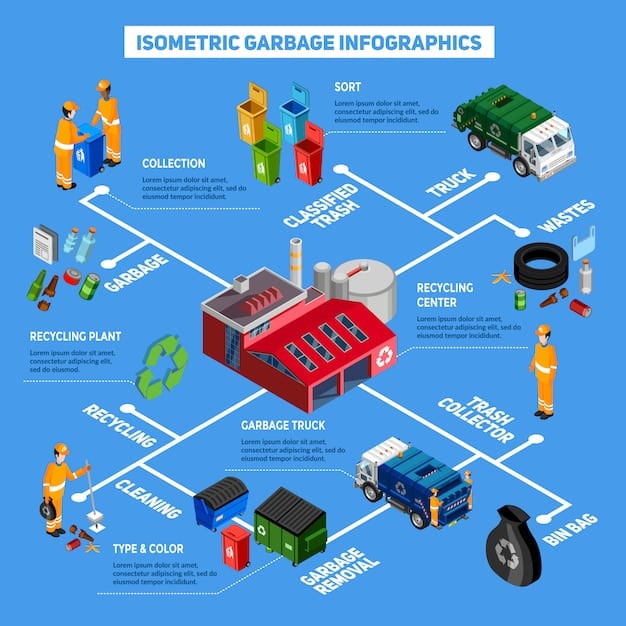Electric Vehicle Battery Recycling: Automakers’ Strategies in the US

Automakers in the US are addressing electric vehicle (EV) battery recycling challenges by investing in research and development, forming strategic partnerships with recycling companies, and advocating for standardized regulations and extended producer responsibility.
The rise of electric vehicles (EVs) in the United States presents a significant environmental opportunity, but it also introduces a complex challenge: what to do with the batteries once they reach the end of their lifespan. How are automakers addressing the challenges of electric vehicle battery recycling in the US? This article delves into the innovative strategies and collaborative efforts shaping the future of EV battery recycling in the nation.
The Growing Urgency of EV Battery Recycling
As electric vehicles become increasingly popular, the disposal of their batteries is becoming a pressing issue. The materials used in these batteries, such as lithium, cobalt, and nickel, are valuable and finite resources. Recycling these batteries not only recovers these materials but also prevents environmental pollution and reduces the need for mining new resources.
The increasing sales of EVs and stricter environmental regulations highlight the need for a robust battery recycling infrastructure. Automakers are recognizing this need and are taking proactive steps to address it.
Environmental and Economic Benefits
EV battery recycling offers several key benefits. Environmentally, it reduces the demand for new raw materials, which often come from environmentally sensitive areas. Economically, it creates a secondary supply of valuable materials, reducing reliance on international markets and stabilizing supply chains.
- ♻️ Reduced Environmental Impact: Minimizes mining and processing of raw materials.
- 💰 Economic Value: Recovers valuable materials like lithium, cobalt, and nickel.
- 🛡️ Stable Supply Chains: Reduces dependence on international markets for battery materials.
By investing in recycling technologies, automakers can create a closed-loop system, where materials from old batteries are used to produce new ones, promoting a more sustainable future.

Automakers’ Recycling Initiatives
Many automakers are launching their own initiatives focused on the lifecycle of EV batteries. These programs vary in scope, but they all share the common goal of minimizing environmental impact and maximizing resource recovery.
Some automakers are focusing on design improvements to make batteries easier to disassemble and recycle. Others are partnering with specialized recycling companies to ensure responsible handling of end-of-life batteries.
Design for Recycling
One of the key strategies is to design batteries with recycling in mind. This involves using fewer hazardous materials, simplifying the battery structure, and making it easier to separate components.
For instance, some automakers are exploring the use of modular battery designs that can be easily disassembled and reused. This approach not only facilitates recycling but also extends the lifespan of the battery by allowing individual modules to be replaced or upgraded.
Partnerships with Recycling Companies
Given the complexity of battery recycling, many automakers are forming partnerships with specialized recycling companies. These partnerships bring together the expertise and infrastructure needed to efficiently and safely recycle EV batteries.
- 🤝 Collaboration: Strategic alliances with specialized recycling firms.
- 🏭 Infrastructure Development: Joint investments in advanced recycling facilities.
- 🔬 Technology Sharing: Collaboration on new and efficient recycling processes.
These recycling companies employ various technologies, including hydrometallurgy and pyrometallurgy, to recover valuable materials from spent batteries. The recovered materials can then be used to manufacture new batteries, creating a circular economy.
Through these initiatives, automakers are taking responsibility for the end-of-life management of their products, ensuring compliance with environmental regulations and promoting sustainable practices.
Technological Innovations in Battery Recycling
The battery recycling industry is rapidly evolving, with numerous technological innovations aimed at improving efficiency and reducing costs. These advancements are crucial for making EV battery recycling economically viable and environmentally sustainable.
Traditional recycling methods, such as pyrometallurgy (smelting), are effective but can be energy-intensive and may not recover all valuable materials. Newer methods, such as hydrometallurgy (chemical extraction), offer higher material recovery rates and lower environmental impact.
Hydrometallurgical Processes
Hydrometallurgy involves using chemical solutions to dissolve and separate battery components. This method can recover a wide range of materials, including lithium, cobalt, nickel, and manganese, with high purity.
The key advantages of hydrometallurgy include its ability to handle different battery chemistries and its lower energy consumption compared to pyrometallurgy. However, it also requires careful management of chemical waste to prevent pollution.
Direct Recycling
Direct recycling, also known as “battery-to-battery” recycling, aims to refurbish or directly reuse battery components without breaking them down into their constituent materials. This approach can significantly reduce energy consumption and waste.
- 🔋 Battery Refurbishing: Extending the lifespan of EV batteries.
- 🔄 Direct Reuse: Utilizing battery components without extensive processing.
- ✨ Efficiency: Lower energy consumption and reduced waste.
Direct recycling is particularly suitable for batteries that are still in good condition but no longer meet the performance requirements of EVs. These batteries can be repurposed for other applications, such as energy storage systems.
These technological advancements are driving the development of more efficient, cost-effective, and environmentally friendly recycling processes, paving the way for a circular economy for EV batteries.

Regulatory Landscape and Policy Support
Government regulations and policies play a critical role in promoting EV battery recycling. By setting clear standards and providing incentives, policymakers can create a level playing field and encourage investment in recycling infrastructure.
Currently, regulations regarding EV battery recycling vary across different states in the US. Some states have adopted extended producer responsibility (EPR) laws, which hold manufacturers responsible for the end-of-life management of their products.
Extended Producer Responsibility (EPR)
EPR policies require automakers to take responsibility for collecting, recycling, or properly disposing of EV batteries. This can be achieved through individual or collective schemes, where automakers work together to establish recycling infrastructure.
EPR laws incentivize automakers to design batteries that are easier to recycle and to invest in recycling technologies. They also ensure that end-of-life batteries are managed responsibly, preventing environmental pollution.
Incentives and Subsidies
In addition to regulations, government incentives and subsidies can further encourage EV battery recycling. These can include tax credits, grants, and low-interest loans for companies investing in recycling facilities and technologies.
- 💰 Tax Credits: Encouraging investments in recycling facilities.
- grants: Supporting research and development of recycling technologies.
- 🏦 Low-Interest Loans: Facilitating infrastructure development.
By providing financial support, governments can reduce the economic barriers to recycling and accelerate the deployment of recycling infrastructure. This can help to create a more sustainable and circular economy for EV batteries.
Clear and consistent regulations, coupled with targeted incentives, are essential for fostering a thriving EV battery recycling industry in the US.
Logistical Challenges and Infrastructure Needs
One of the significant challenges in EV battery recycling is logistics. Collecting and transporting end-of-life batteries from various locations to recycling facilities can be complex and costly.
The current infrastructure for collecting and processing EV batteries is still limited, especially in rural areas. Building a robust and efficient logistics network is essential for ensuring that batteries are recycled properly and that valuable materials are recovered.
Collection and Transportation
Establishing efficient collection points and transportation networks is critical. Automakers, recycling companies, and government agencies need to collaborate to create a seamless system for collecting end-of-life batteries.
This can involve setting up collection centers at dealerships, repair shops, and public recycling facilities. Proper handling and transportation protocols are also essential to prevent damage to the batteries and ensure safety.
Processing Capacity
Increasing processing capacity is another key challenge. As the number of EVs on the road grows, the demand for recycling facilities will also increase. Expanding the capacity of existing facilities and building new ones is necessary to meet this demand.
- ⬆️ Capacity Expansion: Scaling up existing recycling facilities.
- 🏗️ New Facilities: Investing in state-of-the-art recycling plants.
- 🗺️ Strategic Locations: Establishing facilities in key regions to optimize logistics.
Investing in advanced recycling technologies and training skilled workers are also crucial for ensuring that processing facilities operate efficiently and safely.
Addressing these logistical challenges and infrastructure needs is essential for creating a viable and sustainable EV battery recycling industry in the US.
Future Outlook and Sustainable Practices
The future of EV battery recycling looks promising, with ongoing innovations and increasing awareness of the importance of sustainable practices. As technology advances and regulations become more stringent, the industry is poised for significant growth.
Automakers, recycling companies, and policymakers are working together to create a circular economy for EV batteries, where materials are continuously recycled and reused. This approach not only reduces environmental impact but also creates economic opportunities.
Circular Economy Initiatives
Promoting circular economy initiatives is essential for creating a sustainable future for EV batteries. This involves designing batteries that are easy to recycle, investing in recycling technologies, and encouraging the reuse of recovered materials.
Automakers can also work with suppliers to develop new battery chemistries that are more sustainable and easier to recycle. This can involve using more abundant and less toxic materials, as well as designing batteries with fewer components.
Consumer Awareness and Education
Raising consumer awareness about the importance of EV battery recycling is also crucial. Educating consumers about the benefits of recycling and providing convenient recycling options can encourage them to participate in the process.
- 📢 Public Campaigns: Highlighting the environmental and economic benefits of EV battery recycling.
- ℹ️ Educational Resources: Providing information on proper battery disposal methods.
- ♻️ Convenient Options: Establishing accessible collection points and recycling facilities.
By fostering a culture of sustainability and promoting responsible practices, we can ensure that EV battery recycling becomes an integral part of the transition to electric mobility.
| Key Point | Brief Description |
|---|---|
| ♻️ Recycling Urgency | Growing EV adoption requires effective battery recycling. |
| 🤝 Automaker Initiatives | Automakers are investing in design and recycling partnerships. |
| ✨ Tech Innovations | Hydrometallurgy and direct recycling improve material recovery. |
| 🛡️ Policy Support | Regulations and incentives are driving recycling efforts. |
Frequently Asked Questions
▼
EV battery recycling conserves valuable resources and reduces environmental impact by reusing materials like lithium and cobalt, reducing the need for new mining operations.
▼
Automakers are investing in recycling technology, partnering with recycling firms, and designing batteries that are easier to disassemble and recycle efficiently.
▼
EPR makes manufacturers responsible for end-of-life management of their products, encouraging them to invest in recycling and sustainable design practices.
▼
The main challenges include logistical complexities in collecting batteries, expanding processing capacity, and the need for consistent regulatory frameworks across states.
▼
Hydrometallurgy offers higher material recovery rates and lower energy consumption compared to older methods since it can extract different component with high purity.
Conclusion
In conclusion, the journey towards sustainable electric vehicle battery recycling in the US is multifaceted, involving technological innovation, strategic partnerships, policy support, and logistical solutions. As automakers continue to address these challenges proactively, the vision of a closed-loop, circular economy for EV batteries is becoming increasingly attainable, promising both environmental and economic benefits for the nation.





